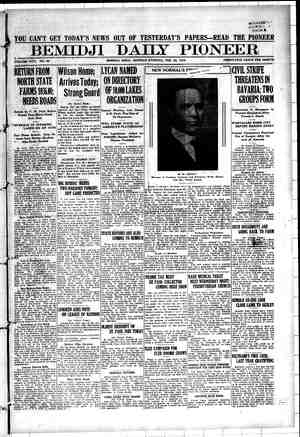The Nonpartisan Leader Newspaper, February 24, 1919, Page 3
You have reached the hourly page view limit. Unlock higher limit to our entire archive!
Subscribers enjoy higher page view limit, downloads, and exclusive features.
In the -interest of a square deal for the farmers VOL. 8, NO. 8 Monpartigin Rader Official Magazine of the Na.ional Nonpartisan League ST. PAUL, MINNESOTA, FEERUARY 24, 1019 A magazine that dares to . print the truth WHOLE NUMBER 179 THAT CAMOUFLAGE OF OURS IS GREAT STUFF | LET'S MAKE 1T $16.50 TOoDAY 2 " vyt fi%?* Among the things the war hus developed is the art of camouflage. i 1l Al { ,\‘ f ?iulflm Yl '\:1 - it'is a veri handy weapon for the special interests. WHAT KEEM COMPETITION] Cartoonist Foss here gives a graphic iilustration of how the packers have seized on the method to deceive the public. The cleverest means that money can secure are used to make the people believe that there is competition between the big packers, while behind the camouflage they chuckle to themselves on their cuteness and merrily arrange the markets in their own interests. - But if the war has developed camouflage it has at the same time made the people aware of it as never before. The farmers of the Northwest have become expert camouflage detectors. They all see “around the corner” of those packer ads, and yet those ads are the last word in camouflage. Labor Gets Fair Deal—From Farmers - Nonpartisan League Caucus Approves Bills Submitted by Union Men of : North Dakota—No Jokers Added—Some Already Signed BY E.'B. FUSSELL WO or three years ago there was printed a- map of the United States, on which the state of North Dakota showed up as an oblong black spot. It was not a map put out by big business, either, because this was before the Nonpartisan league had be- come a power. The map was issued by organized labor. It showed North Dakota as a black spot because there was virtually no labor legislation at all. Organized labor is numerically weak in North Dakota. ' Be- - cause labor was not strong enough to-demand leg- _islation, and enforce its 'demand, it got nothing. While every western state had a workmen’s com- pensation act of some sort, North Dakota had none. It had no laws protecting women and children, no laws protecting workmen against mine accidents, none protecting labor against injunction processes —virtually no labor legislation whatever. Today, if organized labor were to make a new map of the United States, North Dakota, instead of showing up as a black spot, would shine out like an arc light in the night. Labor legislation enacted by organized farm- : : ers has made the difference. The old system, by which politicians succeeded in lining up farmers on one side and labor on the other, has passed in North Dakota. Two union labor men, George A. Malone of Wilton, a coal miner, and * PAGE THBEE - pensation acts of some kind or other. John O’Brien of Jamestown, a barber, both in- dorsed by the League and meeting with the League farmers in caucus, have introduced the bills that are putting North Dakota in the front rank of labor states. The League farmers in both houses of the legislature are furnishing the votes that are passing these bills. House bill No. 56, the workmen’s compensation act, is one of the most important of the new bills. Two-thirds of the states have workmen’s compen- sation acts of some kind or other. League farmers attempted to pass one at the last session of the _ legislature, but the old-gang senate prevented. Two-thirds of the states have workmen’s com- But many of these acts, if not most (_)f them, are for the benefit






